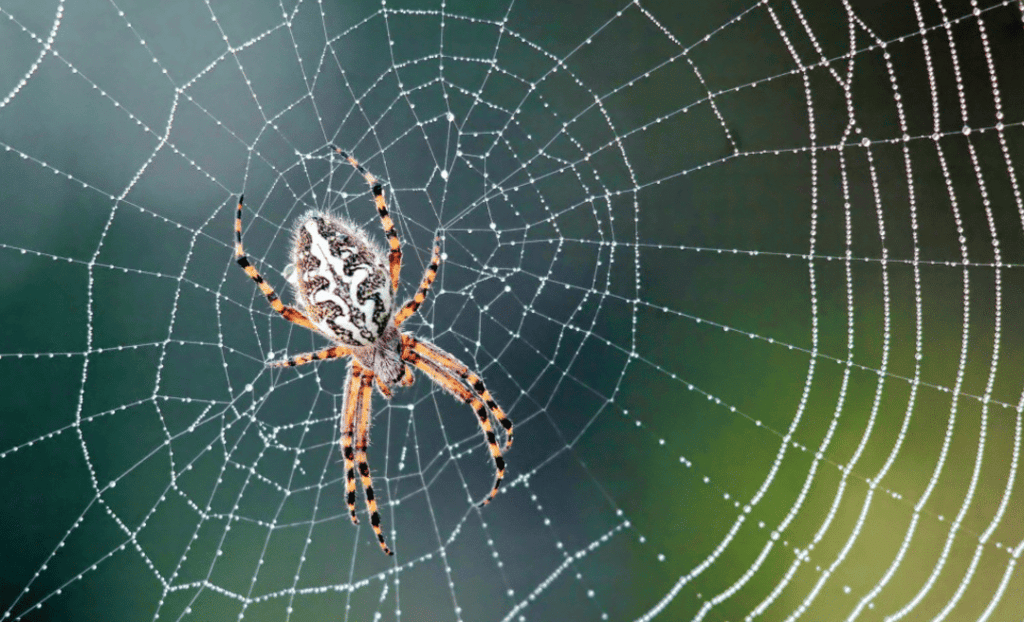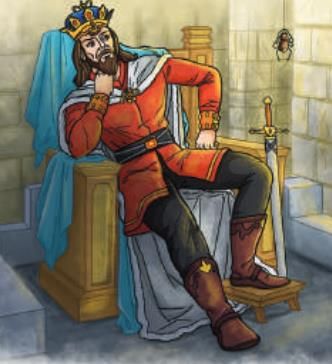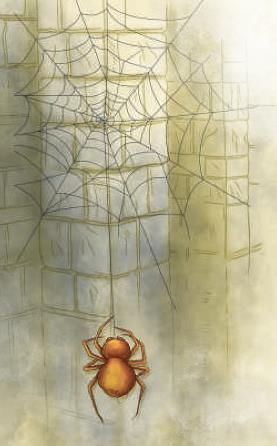Multiple Choice Questions (MCQs)
Q1: Who is the poet of “King Bruce and the Spider”?
a) Kamala Nair
b) Eliza Cook
c) King Bruce
d) Robert Burns
Ans: b) Eliza Cook
The poem is written by Eliza Cook.

Q2: Why is King Bruce feeling sad in the beginning of the poem?
a) He lost his crown
b) He failed to achieve a great deed
c) His people were angry with him
d) He was sick and tired
Ans: b) He failed to achieve a great deed
The poem explains that King Bruce is sad because he repeatedly failed to accomplish a great deed to make his people glad.
Q3: What does the spider do after falling multiple times?
a) It gives up and leaves
b) It keeps trying to climb the thread
c) It builds a new web
d) It waits for help
Ans: b) It keeps trying to climb the thread
The spider falls multiple times but continues to climb the thread without giving up, as described in stanzas 5 and 6. It does not leave, build a new web, or wait for help.
Q4: How many attempts does the spider make to reach its web, as counted by the poet?
a) Six
b) Seven
c) Eight
d) Nine
Ans: d) Nine
Stanza 6 states that the spider makes nine brave attempts to climb the thread, each ending in a fall, before succeeding on the tenth try.

Q5: What does the word “endeavour” mean in the poem?
a) A feeling of sadness
b) A strong effort
c) A thin thread
d) A quick fall
Ans: b) A strong effort
The word “endeavour” is defined in the poem as a strong effort, describing the spider’s determined climb.
Fill in the Blank
Q1: King Bruce watches a _______ trying to climb to its web.
Ans: spider
Q2: The spider’s thread is described as a _______ clue.
Ans: silken
Q3: The king feels _______ after failing to make his people glad.
Ans: sad
Q4: The spider reaches its _______ after its final effort.
Ans: web
Q5: The word “toils” in the poem means to work very _______.
Ans: hardTrue or False
Q1: King Bruce decides to give up his efforts before watching the spider.
Ans: True
In stanza 3, King Bruce, in despair, says, “I’ll give it all up,” before noticing the spider.
Q2: The spider reaches its web on its first attempt.
Ans: False
The spider falls multiple times, making nine attempts before succeeding on the tenth try.

Q3: The poem teaches that perseverance can lead to success.
Ans: True
The moral emphasizes that the spider’s and King Bruce’s persistence leads to success.
Q4: King Bruce thinks the spider is wise for trying repeatedly.
Ans: False
King Bruce calls the spider “foolish” in stanza 7 for trying despite repeated falls.
Q5: The word “monarch” means a spider’s web.
Ans: False
“Monarch” means a king or queen, referring to King Bruce, not a spider’s web.
Very Short Answer Questions
Q1: What is the name of the king in the poem?
Ans: Bruce
Q2: Where is the spider trying to climb?
Ans: To its web
Q3: What does King Bruce say when the spider succeeds?
Ans: “Bravo, bravo!”
Q4: What inspires King Bruce to try again?
Ans: The spider’s persistence
Q5: What does the word “despair” mean in the poem?
Ans: Sadness and hopelessnessLong Answer Questions
Q1: How does the spider’s persistence influence King Bruce’s actions in the poem?
Ans: The spider’s persistence profoundly influences King Bruce. Initially, he is in despair, ready to abandon his efforts after repeated failures. However, watching the spider make nine unsuccessful attempts to climb its thread, only to succeed on the tenth try, inspires him. The spider’s refusal to give up despite falling repeatedly shows King Bruce that perseverance can lead to success. Moved by this, he praises the spider, saying it “defied despair,” and resolves to try again, leading to his eventual success. The spider’s example shifts his mindset from hopelessness to determination.
Q2: Describe the spider’s efforts to reach its web and the challenges it faces.
Ans: The spider’s efforts to reach its web are marked by determination and repeated failures. It begins by climbing a thin, silken thread toward its web near the ceiling, described as a long and tiring journey. The thread is delicate, making the climb difficult for its small feet. The spider falls multiple times, slipping back to the ground, feeling dizzy and faint after some attempts. Despite these setbacks, it persists, climbing up and down, sometimes fast and sometimes slow, making nine brave attempts before succeeding on the tenth try with a final bold effort, overcoming the fragile thread and its own exhaustion.
Q3: Explain the moral of the poem with reference to King Bruce’s experience.
Ans: The moral of the poem is that perseverance leads to success, even after multiple failures. King Bruce’s experience illustrates this: he is initially disheartened by his unsuccessful attempts to achieve a great deed for his people and considers giving up. However, the spider’s relentless efforts to reach its web, despite falling nine times, inspire it to try again. His final attempt succeeds, showing that failures are stepping stones to success if one remains determined. The poem teaches that staying strong and persistent, as King Bruce does, can turn despair into victory.
Q4: How does the poet create suspense in the poem while describing the spider’s attempts?
Ans: The poet creates suspense by detailing the spider’s repeated failures and building anticipation about its success. In stanzas 5 and 6, the spider’s falls are vividly described, with phrases like “slippery sprawl” and “dizzy and faint,” highlighting the difficulty of its task. The counting of “nine brave attempts” in stanza 6 increases tension, as each failure brings the spider closer to giving up. In stanza 8, the poet heightens suspense with phrases like “’tis an anxious minute” and “Oh say, will he lose or win it?” as the spider is just a foot from its goal, keeping readers eager to know the outcome.
Q5: Discuss how the poem uses the spider as a symbol to teach a lesson about resilience.
Ans: The spider in the poem symbolises resilience, serving as a powerful example for King Bruce and readers. Its persistent efforts to climb a fragile thread, despite falling nine times, represent the ability to keep going in the face of setbacks. The spider’s small size and delicate task contrast with its determination, showing that resilience is not about strength but about perseverance. By succeeding on its tenth attempt, the spider teaches King Bruce to defy despair and try again, inspiring his own success. The poem uses the spider to convey that resilience, like the spider’s steady climbs, can lead to achieving one’s goals, no matter how challenging the journey.